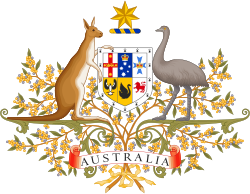Department of Health (Australia)
The Department of Health is a department of the Government of Australia charged with overseeing the running of Australia's health system, including supporting universal and affordable access to medical, pharmaceutical and hospital services, as well as helping people to stay healthy through health promotion, participation and exercise and other disease prevention activities.
_logo.svg.png) | |
 The Sirius Building, the head office of the Department of Health, in Woden, ACT. | |
| Department overview | |
|---|---|
| Formed | 18 September 2013[1] |
| Preceding department | |
| Jurisdiction | Australia |
| Headquarters | Canberra |
| Employees | 4,486 (2017-18)[2] |
| Ministers responsible |
|
| Department executives |
|
| Website | health |
The incumbent Secretary is Brendan Murphy, who succeeded Glenys Beauchamp in July 2020. The incumbent Chief Medical Officer of Australia is Paul Kelly, who succeeded Brendan Murphy in June 2020. Both positions can occasionally be held by the same person.[3] The incumbent Minister for Health is Greg Hunt, in office since January 2017. The junior ministers within the health portfolio are Richard Colbeck (Minister for Aged Care and Senior Australians, Minister for Youth and Sport; in office since May 2019) and Mark Coulton (Minister for Regional Health, Regional Communications and Local Government; since February 2020).[4]
Scope
According to the Administrative Arrangements Order issued 18 September 2013, matters dealt with by the Department are:[5]
- Public health, including health protection, and medical research
- Health promotion and disease prevention
- Primary health care
- Hospitals funding and policy, including relationships and linkages within the continuum of health care
- Implementation of the National Health and Hospitals Network
- Health research
- Pharmaceutical benefits
- Health benefits schemes
- Hearing services policy and funding
- Specific health services, including human quarantine
- Sport and recreation
- National drug strategy
- Regulation of therapeutic goods
- Notification and assessment of industrial chemicals
- Gene technology regulation
- Medical indemnity insurance issues
- Private health insurance
- Blood, Organ and Dental policy and funding
- Health workforce capacity
- Mental health policy and primary mental health care
History
The first Department of Health was established in 1921 and was the precursor to today's Department of Health.[6] It was dissolved in 1987, when it was merged with the Department of Community Services to form the Department of Community Services and Health.[7][8]
In June 1991, the Department of Health, Housing and Community Services was formed when housing industry programs were transferred from the Department of Industry, Technology and Commerce.[9] In March 1993 the Department of Immigration, Local Government and Ethnic Affairs joined with the Department of Health, Housing and Community Services to form the Department of Health, Housing, Local Government and Community Services.[10] Subsequently, in December 1993, the Department was abolished and replaced with the Department of Human Services and Health.[7][11] Also in 1994, the Office of Aboriginal and Torres Strait Islander Health was established.[7]
After a new government was elected in March 1996, the Department of Health and Family Services was formed.[7][12] The department also had responsibility for the Supported Accommodation Assistance Program from the former Department of Housing and Regional Development. Later, the department assumed responsibility for Aboriginal and Torres Strait Islander health matters from the Aboriginal and Torres Strait Islander Commission.[7]
After the October 1998 election, the Department was abolished and replaced by the Australian Federal Department of Health and Aged Care, named to reflect new responsibilities and functions.[13] Responsibility for Family and Children's Services, Disability Programs and the Commonwealth Rehabilitation Service were transferred to the Department of Family and Community Services on 22 October 1998.[7]
Following the November 2001 election, the Australian Federal Department of Health and Aged Care was abolished and replaced with the Australian Federal Department of Health and Ageing.[14] The Australian Federal Department of Health and Ageing was abolished in 2013 and replaced by the current Australian Federal Department of Health on 18 September 2013 by way of an Administrative Arrangements Order issued by the Governor-General of Australia on the recommendation of the Abbott Government.[5]
Role of Secretary
Chief Medical Officer Professor Brendan Murphy, was appointed Secretary of the Department, commencing 13 July 2020 (was originally to commence 1 March 2020). He is the first medical doctor to serve as Secretary.[15] He went on to become "the public face of Australia's fight against COVID-19" during the COVID-19 pandemic in Australia,[16] giving several press conferences with the Prime Minister, Scott Morrison,[17] and Health Minister Greg Hunt.[18]
See also
- Minister for Health
- Minister for Ageing
- List of Australian Commonwealth Government entities
References
- CA 9436: Department of Health [II], Central Office, National Archives of Australia, retrieved 9 April 2014
- Australian Public Service Commission (2018), https://web.archive.org/web/20141005120746/http://www.apsc.gov.au/about-the-apsc/parliamentary/aps-statistical-bulletin/aps-statistical-bulletin-2013-14/main-features, archived from the original (PDF) on 5 October 2014 Missing or empty
|title=(help) - "Professor Brendan Murphy appointed Department of Health secretary". Australian Medical Association. 23 January 2020. Retrieved 25 April 2020.
- "Ministers". Department of Health. Retrieved 25 April 2020.
- "Administrative Arrangements Order of 18 September 2013" (PDF). Department of the Prime Minister and Cabinet. 18 September 2013. Archived from the original (PDF) on 22 September 2013.
- CA 17: Department of Health, Central Office, National Archives of Australia, retrieved 15 December 2013
- Department of Health, History of the Department, Department of Health, archived from the original on 9 November 2013
- CA 5985: Department of Community Services and Health, Central Office, National Archives of Australia, retrieved 15 December 2013
- CA 7297: Department of Health, Housing and Community Services, Central Office, National Archives of Australia, retrieved 15 December 2013
- CA 7660: Department of Health, Housing, Local Government and Community Services, Central Office, National Archives of Australia, retrieved 15 December 2013
- CA 7853: Department of Human Services and Health, Central Office, National Archives of Australia, retrieved 15 December 2013
- CA 8246: Department of Health and Family Services, Central Office, National Archives of Australia, retrieved 15 December 2013
- CA 8616: Department of Health and Aged Care, Central Office, National Archives of Australia, retrieved 15 December 2013
- CA 8867: Department of Health and Ageing, Central Office, National Archives of Australia, retrieved 15 December 2013
- "Professor Brendan Murphy appointed Department of Health Secretary". Australian Medical Association. 23 January 2020. Retrieved 30 March 2020.
- Topsfield, Jewel (20 March 2020). "Coronavirus Australia: Brendan Murphy: the public face of Australia's fight against COVID-19". The Sydney Morning Herald. Retrieved 30 March 2020.
- "Press conference with Premiers and Chief Ministers - Parramatta, NSW". Prime Minister of Australia (in Swahili). Retrieved 30 March 2020.
- "Chief Medical Officer and Minister Hunt's joint press conference on coronavirus (COVID-19)". Australian Government Department of Health. 3 March 2020. Retrieved 30 March 2020.

